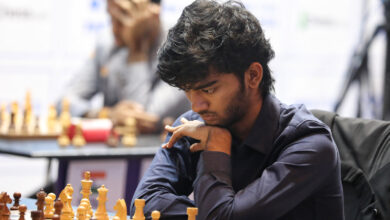IND vs AUS: With mystique release, Ravichandran Ashwin spins his own script

At one point on Friday afternoon under a burning sun, Ravichandran Ashwin, with his sun-burnt face, slumped forward near the boundary line, and a support staff applied an ice pack on his neck and behind the ears. Not just the docile track but the harsh heat was conspiring against him. Yet, on the first batting beauty of the series, it was Ashwin who hauled in six wickets to prevent Australia from totally running away with the game. In some sense, India’s last series in Bangladesh, where he “wasn’t at my best” had made him ready for these gruelling two days in Ahmedabad.
In the recent past, with his pursuit of a spot in the T20 team, and in that Bangladesh series, the one element of his art that was missing was the trickery in the air. The clever fingers, the different breaks, the under-cut ball, and the amount of spin on turners had taken center stage. In Ahmedabad, all those components were present, but it was what he did in the air that stood out. Even in his mind, for that matter. “It’s doing a lot more in the air than it did in Bangladesh,” he said after his 6 for 91 spell.
For that he has changed his load-up for the series. And in this game, he experimented with two varieties of them. Load-up is how a spinner gathers the ball, sets himself up prior to the release – and along with the wr-cock, it determines the angle, the trajectory, and even the speed. Through the series, he has been loading them up pretty high, and in this game, at different stages, he dropped it down.
ICYMI!
A splendid six-wicket haul ft. @ashwinravi99 🫡#TeamIndia | #INDvAUS | @mastercardindia
WATCH his excellent bowling spell here 🎥🔽https://t.co/fCYxw511PQ
— BCCI (@BCCI) March 10, 2023
“The change of load-up, cocking my action have made my spells a lot more penetrative than Bangladesh … (The change in load-up) was to try to get the batsmen to miss the pace of it, or the trajectory of it . Whenever I bowl with that action trajectory is different, you tend to go back to the ball that is a bit fuller. That’s what Khawaja did all through the game. That was the idea of it. I wanted to see if I can get a bit more purchase off the wicket as the wr cock of can get the seam different.”
Then with an impish smile that lit up his face, Ashwin would add, “All these are little complexities inside my head. However the way it comes out is how the batsmen sees it.”
Those little complexities have given the watchers great pleasure over the years. It’s insane really that an off-spinner, whose art isn’t wry as Muttiah Muralitharan’s was, has scalped 473 wickets at 23.86. It would have been understandable if he was a wr spinner with inherent ability to spin and loop the ball a lot more, or of course a skillful fast bowler with the added luxury of cheap tailenders’ wickets. Even considering the pitches, it’s a remarkable achievement.
! 🔥🔥
A sigh of relief for #TeamIndia as @ashwinravi99 strikes twice in an over to remove Cameron Green and Alex Carey 💪🏻💪🏻
Follow the match ▶️ https://t.co/8DPghkx0DE#INDvAUS | @mastercardindia pic.twitter.com/e8caRqCHOq
— BCCI (@BCCI) March 10, 2023
It was Australian spinner Mitchell Swepson who nailed Ashwin’s secret couple of years ago. “The batsmen have to watch his hands closely which gives them less time to move and they sort of stay in the crease a bit. It (the watching) cuts their reaction time and that’s probably his biggest asset.”
Wonderfully put. Ashwin’s mystique doesn’t necessarily lie in what comes out of his hands – he isn’t a mystery spinner, but the way he preps up his release, he cuts the reaction time of the batsmen. But how does a batsman see it? Another Australian Matt Renshaw, who struggled this series, had once detailed the Ashwin effect on a batsman’s mind. “Working out what he is trying to do is probably the biggest (challenge) and how is he trying to get you out, what fields are in play – the mental side is the biggest thing as a batsman.”
It’s not just the load-up point they are referring to but even his fingers constantly change their position on the ball. When he wants to impart sidespin to get more turn, his index finger cuts the seam. When he wants overspin, he cocks it in, towards him, beside the seam, like a hook, and the extremely supple wr turns like a doorknob to send the ball up and over. And so on and so forth.
And even after it releases, unless it’s a carrom ball or some such, it reveals its trickery under the gaze of the batsmen, rather than reveal its perfection from the moment it was released. It’s a familiar theme with Ashwin. His deliveries are constructed for what a batsman might do, tailored to probe the anticipated response, as opposed to a pre-fabricated line of thought.
The Ahmedabad pitch allowed the Aussies to sit back and play him off the pitch. Even there, he reckons that he had the measure of the likes of Usman Khawaja, who lasted 611 minutes for the longest Test innings an Australian batsman. “Whenever I bowl with that action (different load up at a lower point near his throat/chest) trajectory is different, you tend to go back to the ball that is a bit fuller. That’s what Khawaja did all through the game. That was the idea of it.Pace of the pitch allowed the batsmen to play a lot more off the back foot.”
And that’s the confidence and the beauty of Ashwin’s headspace. For a large chunk of 611 minutes, Khawaja had thwarted Ashwin with a very efficient technique, taking care to get his front leg out of the way, playing with full bat-face, pressing back whenever in doubt, but Ashwin can still confidently walk out of the battle, feeling he had done whatever he could against him on this flat track.







